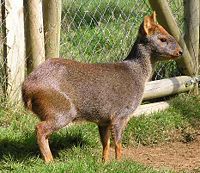Pudu are a rare type of deer that are native to South America and are found in Argentina and Chile. There are two species of pudu: The Northern Pudu, and the slightly larger Southern Pudu. Pudu are the smallest known members of the deer family, and the Northern Pudu stands only 32 cms (one foot) tall. Sadly these endearing creatures are listed as threatened due to habitat depletion and hunting.
Pudu belong to the genus pudu meaning that, unusually, these animals share their common name with their genus name. The Southern Pudu is technically Pudu pudu and the Northern Pudu is Pudu mephistophiles. The two species look very similar. They both have shiny reddish brown coats that have white spots when they are young. Pudu are muscular creatures that are built for jumping, just like their larger relatives. They have short stub-like tails and alert, upright convex ears.
It is not only their size that makes the pudu unique amongst deer. Their vocalization is a sharp bark that they use to raise alarm. Pudu can stand on their hind legs to reach food that would otherwise be inaccessible. And, perhaps most surprisingly, pudu can climb trees to avoid a predator or in pursuit of food. The pudu will eat mainly grass, leaves, and fallen fruit. They live to approximately 8 – 10 years of age, breeding in the autumn, and producing litters of twins in the early months of spring. These creatures will establish complex networks of trails and paths through thick underbrush that allows them to travel without being seen throughout their natural range.
Sadly, the pudu may have to rely on zoological parks and conservationists to survive. Logging and farming in their natural environment is making survival difficult for these animals. Pudu are also a source of meat, which means hunting is also depleting their already unstable numbers in some regions.
Pudu belong to the genus pudu meaning that, unusually, these animals share their common name with their genus name. The Southern Pudu is technically Pudu pudu and the Northern Pudu is Pudu mephistophiles. The two species look very similar. They both have shiny reddish brown coats that have white spots when they are young. Pudu are muscular creatures that are built for jumping, just like their larger relatives. They have short stub-like tails and alert, upright convex ears.
It is not only their size that makes the pudu unique amongst deer. Their vocalization is a sharp bark that they use to raise alarm. Pudu can stand on their hind legs to reach food that would otherwise be inaccessible. And, perhaps most surprisingly, pudu can climb trees to avoid a predator or in pursuit of food. The pudu will eat mainly grass, leaves, and fallen fruit. They live to approximately 8 – 10 years of age, breeding in the autumn, and producing litters of twins in the early months of spring. These creatures will establish complex networks of trails and paths through thick underbrush that allows them to travel without being seen throughout their natural range.
Sadly, the pudu may have to rely on zoological parks and conservationists to survive. Logging and farming in their natural environment is making survival difficult for these animals. Pudu are also a source of meat, which means hunting is also depleting their already unstable numbers in some regions.
